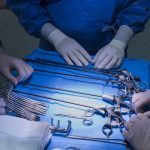Hemorrhoids are collections of submucosal, fibrovascular, arteriovenous sinusoids that are part of the normal anorectum. External hemorrhoids are located distal to the dentate line and internal hemorrhoids are located proximal to the dentate line.
The purpose of these “vascular cushions” is not fully understood, but they appear to be important for sensing fullness and pressure and for perceiving anal contents. In addition, they may support anal closure, facilitate continence, and help protect the anal sphincter from injury during defecation.
Internal Hemorrhoidal complexes are normally collected in the left lateral, right anterolateral, and right posterolateral regions of the anal canal but may be found in other locations.
The risk of symptomatic disease is increased among persons with increased venous pressure and altered venous drainage (owing to cirrhosis with ascites, pregnancy, frequent straining, or prolonged standing or squatting), abnormal bowel function (diarrhea or constipation), collagen vascular abnormalities, clinically significant pelvic floor dysfunction, or a low intake of dietary fiber and among those who are obese or sedentary.
Rectal bleeding typically occurs with or immediately after defecation. Blood may be noticed on toilet paper, in toilet water, or, occasionally, staining the underwear.
A hemorrhoid classification system is useful not only to help in choosing between treatments, but also to allow the comparison of therapeutic outcomes among them. For practical purposes, internal hemorrhoids are further graded based on their appearance and degree of prolapse, known as Goligher’s classification:
(1) First-degree hemorrhoids (grade Ⅰ): The anal cushions bleed but do not prolapse (2) Second-degree hemorrhoids (grade Ⅱ): The anal cushions prolapse through the anus on straining but reduce spontaneously.
(3) Third-degree hemorrhoids (grade Ⅲ): The anal cushions prolapse through the anus on straining or exertion and require manual replacement into the anal canal
(4) Fourth.degree hemorrhoids (grade Ⅳ): The prolapse stays out at all times and is irreducible.
The diagnosis of hemorrhoidal disease is based on a precise patient history and careful clinical examination. Assessment should include a digital examination and anoscopy in the left lateral position. The perianal area should be inspected for anal skin tags, external hemorrhoids, perianal dermatitis from anal discharge or fecal soiling, fistula in ano and anal fissure.
Evaluation of the entire colon is indicated for patients with any of the following: anemia; bleeding that is not typical of hemorrhoids; a change in bowel patterns; a personal history of rectal or colon polyps; a family history of inflammatory bowel disease, colorectal cancer, or other hereditary colorectal diseases in a first-degree relative; or other suspected pathologic pelvic changes that could contribute to the patient’s symptoms.
For correct treatment, all patients should be encouraged to ingest a sufficient amount of insoluble fiber (typically 25 to 35 g per day) and sufficient water to avoid constipation and straining and to limit the time spent on the toilet.
Clinical experience indicates that use of topical glucocorticoids, vasoconstrictors (e.g., phenylephrine-based creams or suppositories), or analgesics may provide temporary relief of some symptoms, but data from randomized trials on long-term efficacy and side effects islacking.
The different non-operative and surgical treatments include:
– Rubber band ligation: Rubber band ligation (RBL) is a simple, quick, and effective means of treating first- and second-degree hemorrhoids and selected patients with third-degree hemorrhoids.
– Sclerotherapy: This is currently recommended as a treatment option for first- and second-degree hemorrhoids.
– Infrared light applied to a site that is immediately proximal to the hemorrhoidal complex induces coagulation necrosis and, ultimately, scarring in patients with low-grade disease.
- Excisional therapies are most appropriate for patients who have grade IV disease, complications, or clinically significant internal and external disease or in whom nonoperative treatment has failed. Hemorrhoidectomy, in which the hemorrhoidal complexes and associated connective tissues are sharply excised and the mucosal defect is closed at least partially, is very effective but painful.













